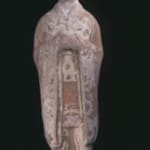Tang Terracotta Polychrome Civil Official, 618 CE - 907 CE
Terracotta
7 x 26.5
H.010
This civil official is dressed according to the rules that dictate official decorum of the day: a black hat, short red robe with loose fitting sleeves, a waistcoat, white trousers...
This civil official is dressed according to the rules that dictate official decorum of the day: a black hat, short red robe with loose fitting sleeves, a waistcoat, white trousers and black shoes with toecaps in the shape of ruyi clouds. The effeminate form of the official is reminiscent of the aesthetic appeal of the upper class who avoided hard labor and remained indoors. They moved with a sense of dignity and grace. In this figurine as well, the features are more refined--rosy red painted lips, slit eyes and fleshy face. Over time, all that remains of the once brightly painted figurine is earthen residue and white slip with faded colors appearing on the waistcoat, robe and headdress. This figurine once resided close to the tomb, as the duty to serve one's sovereign in administrative and academic affairs continued in life and death. Considered to be the finest examples of Chinese burial objects, Tang figurines reached their apex in the first half of the eighth century The important role assigned to these models in Tang tomb arrangements and their significance as status symbols and powerful guardians protecting the dead meant that these clay figures became luxury objects. They reflect the artistic vitality of the time and give a unique perspective into Tang customs and practices as well as the contemporary upper class life.



